ABSTRACT
After the introduction of Roundup Ready® technology, there were changes in community composition of weeds in the Southwest of Goiás. In this sense, this study aimed at evaluating weed distribution in different cropping systems in this region. Thus, phytosociological survey was conducted in three different periods. Studies were conducted on thirty-five areas derived from combined soybean crops resistant to glyphosate and conventional soybean, maize, sorghum, millet or fallow in succession. The number of individuals of weeds, dry biomass of soil surface and edaphoclimatic data was obtained in order to describe the variables responses of floristic composition. The factors associated to the total occurrence of species were evaluated and five species difficult to control (Cenchrus echinatus, Alternanthera tenella, Chamaesyce hirta, Euphorbia heterophylla e Glycine max) in regression analysis on tree were selected. A total of 3,219 individuals among 79 species were recorded. Regarding total occurrence of species period desiccation of main crop pre-planting (44.80 pl. 5 m2) and on sites that showed pH> 5,37 (51.20 pl. 5 m2) had higher infestations. Voluntary soybean was found in off-season, preferably with high sand content. Species of hard control, tolerant or resistant to herbicides were diagnosed in areas study.
Key words: Soybean, tolerance, herbicide.
In Brazil, the cultivation of genetically modified soybean for glyphosate resistance significantly changes the chemical control mechanisms and management in more than 25 million of hectares. This fact associated to the second crop cultivation is the main change diagnosed in Brazilian agricultural systems focused on grain production. These changes have influenced over the years on floristic composition and dynamics of weed communities in different rotation/succession systems of cultures (Balbinot Jr and Veiga, 2014).
Herbicides are the main selection factors of spontaneous plants. In sites where for several years herbicides recommended for the cultivation of conventional soybeans were applied, as imazethapyr, chlorimuron-ethyl, fomesafen, lactofen, haloxyfop-methyl, fluazifop-p-butyl, clethodim, among others, received only glyphosate applications during soybean cycle. This substitution of herbicides has been promoting a change in weed community of agricultural areas. However, this change has not yet been quantified and scientifically qualified in the different Brazilian regions.
In American agriculture, tillage system and intensive glyphosate use in areas of transgenic crops significantly influence composition and weed populations (Swanton et al., 1993; Shaner, 2000). Besides the use in post- emergency in crops with induced resistance, glyphosate is widely used in desiccation operations in pre-planting.
In addition to the use of Roundup Ready® technology, another factors such as local conditions: type of soil, climate, cropping practices, seed bank and more recently the occurrence of tolerant weeds and or resistant to herbicide application, are also associated to occurrence of spontaneous plants in agricultural ecosystems (Adegas et al., 2010). Researchers found that in no-tillage system, some invasive species such as Spermacoce latifolia, Synedrellopsis grisebachii, Commelina benghalensis and Tridax procumbens have been selected due to successive applications of glyphosate in cerrado agricultural areas (Procópio et al., 2007). Other weed species were also reported to be tolerant to herbicides, detaching: Ambrosia artemisiifolia (Kapusta et al., 1994), Sesbastiania exaltata, Ipomoea spp. (Jordan et al., 1997; Lich et al., 1997).
In view of these findings, the glyphosate efficiency, which is herbicide of broad spectrum action mainly used in soybean crop under no-tillage system, in less than a decade of use, is threatened by species occurrence of tolerant and resistant weeds (Webster and Sosnoskie, 2010).
In the southwest region of Goiás, areas that were intended for conventional soybean cultivation, adopted no-tillage system with cultivation of two annual harvests. Soybean is cultivated at the beginning of rainy season and maize, millet and sorghum in the second season (off-season). Changes in chemical control mechanisms and management, promoted by the cultivation of genetically modified soybean and second harvest crops for production of grain and dry biomass of soil surface, associated to edaphoclimatic conditions have influenced floristic composition and weed establishment in this region.
Considering this set of factors, this study aimed at evaluating floristic composition and structure of weed community in different soybean production systems in the Southwest region of Goiás, as well to determine the factors associated to species occurrence considered difficult to control, recorded in the Southwest region of oiás.
Studies were conducted in the Southwest of Goiás, in agricultural areas of Rio Verde, Santa Helena de Goiás, Montividiu and Santo Antonio da Barra municipalities, in the crop year of 2012/2013, from June 2012 to July 2013. Regarding Köppen and Gêiser classification, sites have AW climate: with average temperatures from 23.0 to 24.3 °C and average annual rainfall from 1,510 to 1,663 mm, with the highest concentration in the summer. Winter is dry with mild temperatures and absence of rain between May and September. Soils are Red Latosol Distroferric and Red Latosol Dystrophic types (Santos et al., 2011).
The phytosociological survey was conducted in seven production systems (treatments) with five replications in different properties, which had at least three consecutive years of deployment, totaling thirty-five agricultural areas (Table 1). In these properties, the cultivation of modified soybean for resistance to glyphosate (RR Soybean) and conventional soybeans in crop, with successions of maize, sorghum and millet or fallow in off-season is predominant.
Soil samples were collected in plots of twenty hectares at a depth of 0 or 10 cm, prior to correction activities for summer yield deployment. Twelve single samples to obtain a complete sample were taken. Soil fertility data were used in occurrence correlation of weed species (Table 2).
The field survey was conducted in three evaluation periods: before desiccation for soybean crop deployment; prior to the first herbicides application on post-emergence in soybean crop at twenty days after sowing; prior to the first herbicides application on post-emergence in soybean crop at twenty days after off-season crop deployment, or in fallow area. Weeds were inventoried from the random release of hollow frames (0.5 x 0.5 m) in sample areas and phytosociological analysis based on Braun-Blanquet methodology (1979).
Considering the three seasons of field survey, twenty sampling units in each of five replications were standardized (5 m2 per period or 15 m2 total), totaling 100 units per treatment (25 m2 per period or 75 m2 total) and 700 sampling units in each survey stage (175 m2 per period or 525 m2 total) in 2,100 sampled hollow squares (Table 3).
Weeds present in squares were cut close to the soil and transferred to laboratory for identification and accounting of individual number per species. After botanical identification, it was placed in paper bags to determine the shoot dry biomass, by drying in forced ventilation at 65°C for 72 h and weighted on precision scale.
During phytosociological survey, straw samples of soil surface in hollow square delimitations on each sample unit were collected. Material was placed in cloth bags and dried in air forced ventilation for 72 h at 65°C for determination soil surface dry weight and estimative in tonnes per hectare. The obtained data of the number of individuals per species, shoot dry biomass of weeds and straw dry biomass of soil surface were used in species occurrence analyses according to variables responses of floristic composition.
Field data were processed from the PC-ORD 6.1 Software (McCune and Mefford, 2011). It was created a multivariate matrix for each variable responses descriptors of total floristic composition of the study. The multivariate analyses of tree regression was (multivariate regression tree model) (De'Ath, 2002) was used to model the variable responses depending on type of soybean factors (RR and conventional), crop succession, and edaphoclimatic covariates.
This analysis was performed to describe what combination of factors and its respective levels were associated to changes in response variable,as well relative importance of each one of these factors.
Univariate version of regression tree models (De' Ath and Fabricius, 2000) was used to model the incidence of weeds separately depending on the factors mentioned above. This same approach was used for statistical analysis to evaluate matrices containing only a data subset concerning to most problematic weed control. The components species of this subset were selected after floristic composition survey of areas. The distribution and total occurrence of species were analyzed and five were selected (Cenchrus echinatus, Alternanthera tenella, Chamaesyce hirta, Euphorbia heterophylla and Glycine max) considered difficult to control in the study areas, in the application of tree regression analysis.
A total of 3,219 individuals among 79 species of weeds, which amounted 5,815.74 g of shoot dry matter weight, were surveyed (Table 4). There was a variation in the number of individuals and dry weight of shoot in the different evaluation times, predominantly higher values in period prior desiccation for soybean sowing, with a decrease in the period prior to the post-emergence application of soybean and smooth stabilization in performed survey earlier to post-emergence application of succession crop or second crop.
In this study, it was observed that the conventional soybean + maize treatment showed higher estimative (7.73 t ha-1), followed by RR soybean + millet (6.79 t ha-1) and RR soybean + maize (6.64 t ha-1) (Table 5). The quantity of straw dry biomass on the soil and uniformity of its distribution are reference for qualitative assess-ment of no-tillage system. This system must have at least 6 t ha-1 to have sustainability (Alvarenga et al., 2001).
The combinations RR soybean + sorghum (4.51 t ha-1); conventional soybean+ millet (4.21 t ha-1), conventional soybean + sorghum (4.91 t ha-1) and RR soybean + fallow (4.0 t ha-1) showed lower amounts of dry biomass of surface. These combinations showed amount of straw below the minimum necessary to maintain no-tillage system. This shows the need for higher production of dry biomass of soil recover straw in region. In addition, for the cerrado region notes enhanced rate of decomposition that is intensified by heat and humidity in soil.
In performed works in cerrado areas in Minas Gerais, Resende (1995) found a reduction in the production of straw biomass with delay in sowing time. This author reported average yields of straw of 6.44 and 5.84 t ha-1 for sorghum and millet, respectively. It is noteworthy that the means for millet were lower than data from this study on RR soybean (6.79 t ha-1). Millet, according to Salton and Kiche (1998), produces variable dry biomass with edaphoclimatic conditions, sowing periods and time of cultivation and can reach 5 t ha-1 in less than 60 days.
Usually areas without plant coverage, in the period in which there is no commercial crops, tend to have weed infestations on subsequent cultivation (Silva and Silva, 2007). However, it was recorded in this study that combinations: conventional soybean + maize, RR soybean + millet and RR soybean+ maize; which showed higher mean of dry weight of straw soil surface also showed a higher number of weed species (Table 5). In these treatments only straw surface is not enough to suppress weeds. The chemical management, with applications of grass herbicides in maize and millet in off-season period may be disabled. It is detached that in most analyzed areas, there was no chemical control in the fallow period which led to higher infestation in these off-season crops and increased herbicide applications in main culture.
Regarding total occurrence of weed species to tree containing four terminal nodes explained 51% of the total data variability in the occurrence of total weed data found in the Southwest of Goiás (Figure 1). The determining factor in this analysis was the evaluation periods, with higher weed infestation at desiccation pre-planting time of main crop (average of 44.80 plants per 5 m2) compared to periods that precede post-emergence application in crop and/or off - season (average of 23.90 plants per 5 m2).
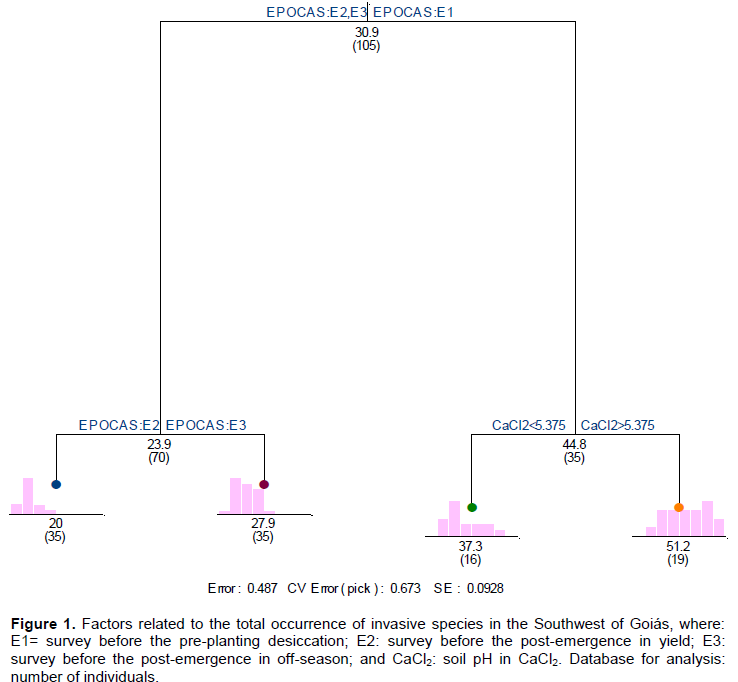
During the second harvest period, the general infestation (average of 27.90 plants per 5 m2) was higher than in the harvest (average of 20.00 plants per 5 m2). The infestation of weeds in the period of pre-plant desiccation was associated to soil pH, and in soils with pH< 5.37 (average of 37.30 plants per 5 m2). The data showed that desiccation is the time in which chemical control is more required due to the higher density of weeds, and also due to the development of species. Soils with more suitable pH ranges favor greater weed infestation, perhaps due to greater availability of nutrients observed in those soils, benefiting both crops and weed community.
Regarding the occurrence of C. echinatus, the tree with five terminal nodes explained 51% of the total variability of data occurrence (Figure 2). The most important factor associated to the occurrence of this species was the percentage of sand in the soil composition, with greater infestation in areas with sand content higher than 47.5% (average of 8.64 plants per 5 m2) compared to other areas (average of 2.79 plants per 5 m2). In areas containing sand content higher than 47.5%, the time of evaluation was also associated to the occurrence of C. echinatus, with 1 and 3 periods, desiccation in pre-sowing and post-emergence in off-season with the highest average (11.0 plants by 5 m2) of C. echinatus at period 2 (yield, 3.86 plants per 5 m2).
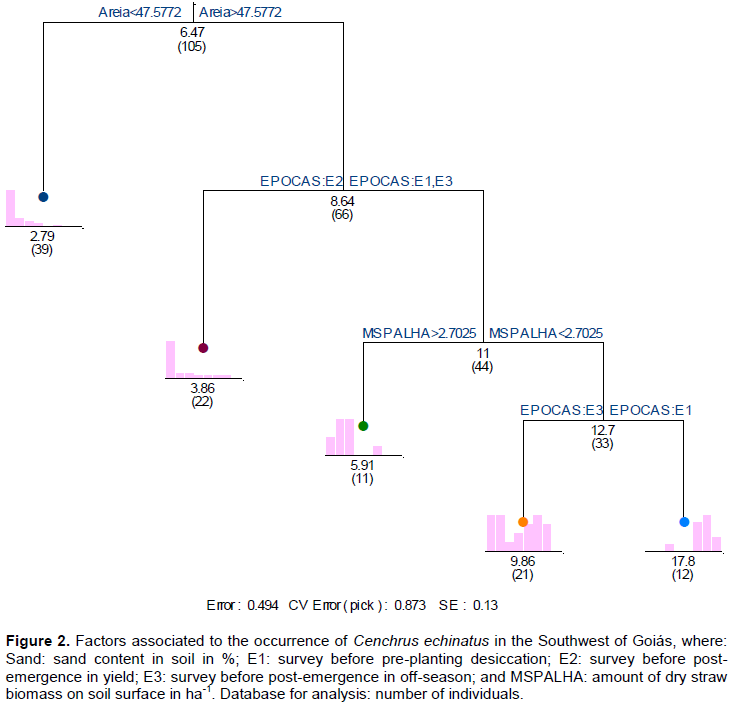
In more sandy areas greater than 47.5%, at periods 1 and 3, it was found that the amount of straw on soil surface was also associated to the occurrence of C. echinatus. Sites with dry straw under 2.7 t ha-1 showed higher infestation (average 12.70 plants per 5 m2) compared to areas with more than 2.7 t ha-1of straw (average 5.91 plants per 5m2). In these areas, with low straw level on soil surface, survey periods were also an important factor to explain the occurrence of this species, a greater number of plants before pre-planting desiccation compared to off-season period was found. From this information, it can be summarized that more sandy areas with low straw biomass on surface facilitates the C. echinatus infestation especially at the period prior to pre-planting desiccation. This shows the low efficiency in off-season control in addition to the natural period of soil fallow. This species is an herbaceous grass of widespread occurrence throughout Brazil, and is considered one of the six most aggressive species in agriculture having great dispersion potential (Kissmann, 1997).
Regarding the factors associated to the occurrence of A. tenella the tree containing four terminal nodes explained 64% of the total variability of data occurrence (Figure 3). The most important factor was soil sand content, where there was the formation of two nodes, one indicating greater infestation of A. tenella in areas with sand content lower than 33.2% (average of 7.04 plants per 5 m2) compared to areas with sand content higher than 33.2% (average of 0.92 plants per 5 m2). In areas with low sand content, two nodes were opened related to the altitude, with larger infestations of A. tenella were accounting in areas with altitude above 868 m, however this occurred in only three locations compared to 68 locations where the incidence of this species remained very low (average of 0.56 plants per 5 m2).
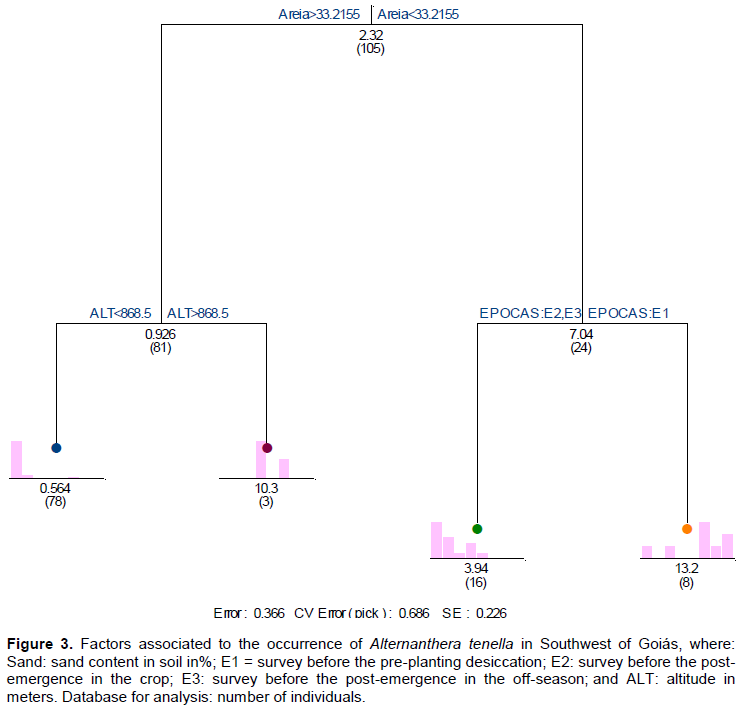
In most clayey areas, two terminal nodes were opened according to counting periods. Surveys conducted at period before pre-planting desiccation show greater infestations of A. tenella (average of 13.20 plants per 5 m2) compared to periods related to harvest and off-season periods (average of 3.94 plants per 5 m2). Clayey soils in sites with milder temperatures (higher altitudes) seem to favor the occurrence of this species, being clearer at the period before the pre-planting desiccation of main crop. According to Canossa et al. (2010), this species is herbaceous plant, highly branched, tending to form an intense coverage on soil. This species spreads by rooting from nodes in contact with soil.
Regarding the factors related to the occurrence of Chamaesyce hirta, tree containing three terminal nodes explained 34% of the total variability of data occurrence (Figure 4). The most important factor was the altitude, with greater C. hirta infestation in areas with lower altitude of 543 m (average of 13.70 plants per 5 m2) compared to areas with higher altitude than this value (average of 2.30 plants per 5 m2). Regarding the higher altitude areas, the amount of straw in soil was associated with the occurrence of this species, with local biomass with straw on soil surface higher than 1.95 t ha-1(average of 3.97 plants per 5 m2) being higher than am locations above 1,95 t ha-1 (average of 1.35 plants per 5 m2). Data show C. hirta “preference” for sites with warmer temperatures (low altitude) and greater amount of straw on soil.
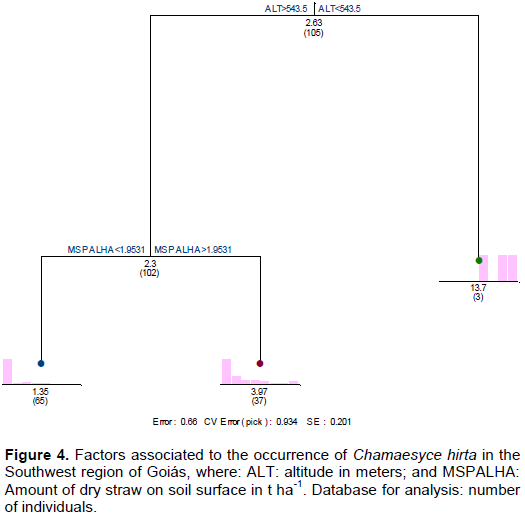
For Euphorbia heterophylla, the tree containing three terminal nodes explained 71% of the total variability of data occurrence (Figure 5). The most important factor was the soil sand content, where there was a formation of two nodes, one indicating higher E. heterophylla infestation in areas with sand content higher than 71.7% (average of 2.96 plants per 5 m2) compared to areas with sand content lower than 71.7% average of 0.26 plants per 5 m2).

Two nodes were opened in areas with sand content exceeding 71.7%, and on conventional soybean cultivation, E. heterophylla incidence was higher (average of 5.83 plants per 5 m2) than in the areas that adopt resistant cultivars to glyphosate (average of 0.67 plants per 5 m2). These data indicate that sandy soils associated to conventional soybean cultivars facilitate the spread of E. heterophylla plants. The high distribution of E. heterophylla biotypes resistant to ALS-inhibiting herbicides used for weed control in conventional soybean crops may explain this result. According to Vargas et al. (2013), the adoption of genetically modified soybean for resistance to glyphosate, represented an alternative to control E. heterophylla biotypes resistant to acetolactato synthase inhibitors.
Regarding the occurrence of soybean (Glycine max) tree with three terminal nodes explained 71% of the total variability of data occurrence (Figure 6). The most important factor were evaluation periods, when there was the formation of two nodes, one indicating higher infestation of volunteer soybeans at off–season period (average of 8.11 plants per 5 m2) compared to pre- planting desiccation periods and before post-emergence application in crop (no record of plant occurrence in these periods).
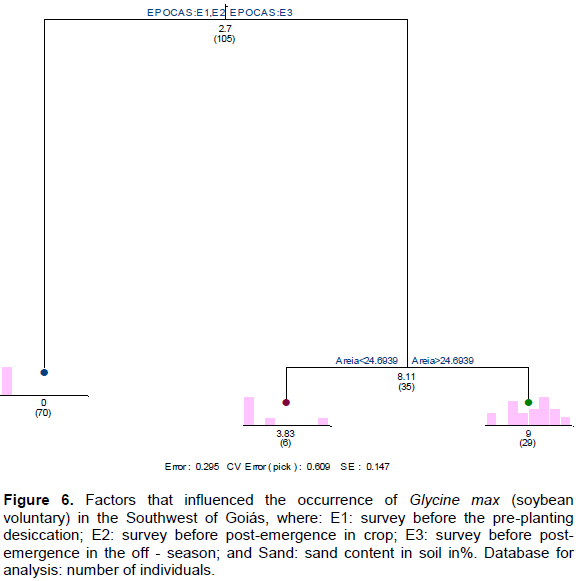
In off-season period, the areas with sand content higher than 24.6% showed a higher number of individuals (average of 9.00 plants per 5 m2) compared to areas with sand content lower than 24.6% (average of 3.83 plants per 5 m2). These data show that the soy infestation problem influences off -season crops, and problem is worse in areas with sandy soil. It is important to note that voluntary soybean plants can cause losses due to weed competition in subsequent crops (Dan et al., 2011).
The cultivation sites in sandy soils with poor dry biomass of straw surface contribute to C. echinatus infestation, especially prior desiccation of soybean pre-planting. Clayey soils and high altitudes favor the occurrence of A. tenella. Sites with low altitude and with higher dry matter content of the straw on soil surface favors the occurrence of C. hirta. Sandy soils associated to the cultivation of soybean conventional varieties in the first crop facilitate the occurrence of E. heterophylla plants. The volunteer soybean has influenced in cultivation of second crop especially in areas with high sand content.
We emphasize that the results obtained with this study, even in a broad geographical context, corroborate with studies carried out in other countries. According to a recent European study soil texture, soil pH and altitude were also among the most important factors determining weed species composition in conventional soybean fields (Pinke et al., 2016). In Europe and even on other continents weed species composition in different crops was most affected by edaphic factors (especially soil pH and soil texture) and altitude (Hanzlik and Gerowitt, 2016).
The authors have not declared any conflict of interests.
REFERENCES
|
Adegas FS, Oliveira MF, Vieira OV, Prete CEC, Gazziero DLP, Voll E (2010). Levantamento fitossociológico de plantas daninhas na cultura do girassol. Rev. Planta Daninha 28:705-716.
Crossref
|
|
|
|
Alvarenga RC, Lara CWA, Cruz JC, Santana DP (2001). Plantas de cobertura de solo para sistema plantio direto. Inf. Agropecu. 22:25-36.
|
|
|
|
|
Balbinot JR AA, Veiga, M (2014). Densidade de plantas daninhas afetada por sistemas de manejo do solo e de adubação. Rev. Ciênc. Agrovet. 13:47-55.
|
|
|
|
|
Braun-Blanquet J (1979). Fitossociologia: bases para el estudio de las comunidades vegetales. 3th edn. Madri: Home Blume Ediciones 820 p.
|
|
|
|
|
Canossa RS, Oliveira JR RS, Constantin J, Rios FA, Cavalieri SD (2010). Efetividade de herbicidas no controle de Alternanthera tenella. Rev. Bras. Herb. 6:1-12.
|
|
|
|
|
Dan HA, Procópio SO, Barroso ALL, Dan LGM, Oliveira neto AM, Guerra, N (2011). Controle de plantas voluntárias de soja com herbicidas utilizados em milho. Rev. Bras. Ciênc. Agrár. 6:253-257.
Crossref
|
|
|
|
|
De'Ath G, Fabricius KE (2000). Classification and regression trees: a powerful yet simple technique for the analysis of complex ecological data. Ecology 81:3178-3192.
Crossref
|
|
|
|
|
De' Ath G (2002). Multivariate regression trees: a new technique for modeling species-environment relationships. Ecology 83:1105-1117.
|
|
|
|
|
Hanzlik K, Gerowitt B (2016). Methods to conduct and analyze weed surveys in arable farming. A review. Agron. Sustain. Dev. 36:11.
Crossref
|
|
|
|
|
Jordan DL, York AC, Griffin JL, Clay P, Vidrine PR, Reynolds DB (1997). Influence of application variables on efficacy of glyphosate. Weed Technol. 11:354-362
|
|
|
|
|
Kapusta G, Krausz RF, Khan M, Matthews JL (1994). Effect of nicosulfuron rate, adjuvant, and weed size on annual weed control in corn (Zea mays). Weed Technol. 8:696-702.
|
|
|
|
|
Kissmann KG (1997). Plantas infestantes e nocivas. São Paulo: Basf Publications 824 p.
|
|
|
|
|
Lich JM, Renner KA, Penner D (1997) Interaction of glyphosate with post emergence soybeans (Glycine max L.) herbicides. Weed Sci. 45:12-21.
|
|
|
|
|
Mccune BJ, Mefford MJ (2011). PC-ORD. Multivariate Analysis of. Ecological Data. Version 6.0 Oregon: MJM.
|
|
|
|
|
Pinke G, Blazsek K, Magyar L, Nagy K, Karácsony P, Czúcz B & Botta-Dukát Z (2016). Weed species composition of conventional soyabean crops in Hungary is determined by environmental, cultural, weed management and site variables. Weed Res. 56:470-481.
Crossref
|
|
|
|
|
Procópio SO, Menezes CCE, Betta L, Betta M (2007). Utilização de chlorimuron-ethyl e imazethapyr na cultura da soja Roundup Ready®. Rev. Planta Daninha 25:365-373.
Crossref
|
|
|
|
|
Resende WG (1995). Efeito da época de semeadura de três leguminosas e três gramíneas forrageiras de inverno para produção de matéria seca e avaliação da cobertura morta em sistema de plantio direto. Monografia. Uberlândia, MG: Universidade Federal de Minas Gerais 40 p.
|
|
|
|
|
Salton JC, Kichel NA (1998). Milheto, uma alternativa para cobertura do solo e alimentação animal. Revista do Plantio Direto 45:41-43.
|
|
|
|
|
Santos HG, Carvalho Júnior W, Dart RO, Áglio MLD, Souza JS, Pares JG, Fontana A, Martins ALS, Oliveira AP (2011). O novo mapa de solos do Brasil. Documentos/Embrapa Solos-130, p. 67.
|
|
|
|
|
Shaner DL (2000). The impact of glyphosate tolerant crops on the use of other herbicides and on resistance management. Pest Manage. Sci. 56:320-326.
Crossref
|
|
|
|
|
Silva AA, Silva JF (2007). Tópicos em manejo de plantas daninhas. P. 17-61. Universidade Federal de Viçosa.
|
|
|
|
|
Swanton CJ, Clements DR, Derksen D (1993). Weed succession under conservation tillage: a hierarchical framework for research and management. Weed Technol. 7:286-297.
|
|
|
|
|
Vargas L, Nohatto MA, Agostinetto D, Bianchi MA, Paula JM, Polidoro E, Toledo RE (2013). Práticas de manejo e a resistência de Euphorbia heterophylla aos inibidores da ALS e tolerância ao glyphosate no Rio Grande do Sul. Rev. Planta Daninha 31:427-432.
Crossref
|
|
|
|
|
Webster TM, Sosnoskie LM (2010). The loss of glyphosate efficacy: a changing weed spectrum in Georgia cotton. Weed Sci. 58:73-77.
Crossref
|
|